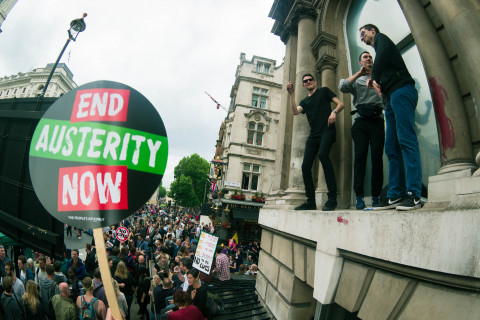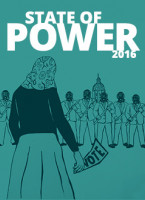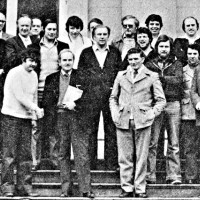New model activism: Putting Labour in office and the people in power
Regiones
The ‘new politics’ needs to be about both winning electoral power and building transformative power.

Flickr - By D B Young
‘Our goal is to increase participatory democracy, solidarity and grassroots power, and to help Labour become the transformative governing party of the 21st century,’ declared three founder members of Momentum (Adam Klug, Emma Rees and James Schneider, in Renewal) in 2016. They acknowledged that this was a ‘highly ambitious project’ and spelt out the extent of this ambition: ‘The aim is not just any Labour government but a Labour government that will shift wealth and power out of the hands of a small elite and into the hands of the overwhelming majority.’
This required, they insisted, ‘more than Corbyn as leader’ – and as prime minister, we might now add. ‘We need to build grassroots power now: the ability for ordinary people to influence and change the world in their interests, through their own institutions. This means developing processes of collective organising that are directed and controlled by those directly affected by decisions. We must maximise people’s participation, agency and empowerment in systems affecting their lives.’
A necessary condition
The tension between these two goals of electing a left-wing prime minister and building grassroots power is at the heart of any debate about the future of Momentum and the Labour Party and of the transformative left more generally. So I want here to explore why this building of ‘grassroots’ is a necessary condition – not an optional bonus – if the left in office is to be the transformational government that the founders and present supporters of Momentum hope for.
How do we deepen what we mean by ‘grassroots power’? What are its different elements? How is it a distinct source of power from the power of government? And how is it possible – under what conditions – to combine these distinct sources of power to realise the potential of both?
I will sharpen the distinction by using the more precise terms of power-as-transformative-capacity (or ‘grassroots power’) and power-as-domination (here the relevant form concerns governmental power). I will go on to explore what forms of organisation and political culture are necessary for building grassroots power, and how these can be in tension with those involved in winning office.
First, then, to lay out the conceptual tools that can help to identify the sources of division and blockage between what in practice need to be combined aspects of a strategy for a transformative left government.
Sources of power
The sources of power necessary for radical transformation are more plural and complex than simply ‘winning government for the left’. Historically, social democratic and communist parties have been built around, at best, a benevolent vision of the understanding of ‘power-as-domination’. Their strategies, exemplified by Attlee’s 1945 government, have been based on the idea of winning government office in order to steer the state apparatus to deliver what the party manifesto proposed to meet the needs of working people.
This is a paternalistic political methodology. Moreover, it is vulnerable to being undermined by the power of private capital because it lacks any productive, material power of its own. Such material power for a party that aims to govern in the interests of the dispossessed can only come through a recognition of ‘power-as-transformative-capacity’ – that is, the power of the dispossessed as knowledgeable economic and social actors – and through a strategy for developing and realising this power.
Power-as-transformative-capacity has been ‘discovered’, or rather inventively practised, by social movements at different moments – for example, 1968 and the 1970s, the late 1990s, and since 2011. Social movements of students, feminists, radical workers (including precarious workers), community activists, and environmentally-conscious and morally-conscientious designers and scientists have moved beyond protest to proposing and directly creating practical, prefigurative solutions, in daily life and as part of political struggle.
The alternative plan for socially useful production drawn up by the Lucas Aerospace workers in the 1970s to resist redundancies is a classic example of the exercise of power-as-transformative-capacity. At the same time as fighting for jobs, they were turning away from making components for military aircraft and creating a prefigurative alternative as part of a politicised industrial struggle. In the end, despite widespread support, this alternative was blocked by the exercise of power-as-domination – by management defending its prerogatives, by a Labour government defending its monopoly on politics, and by a trade union leadership threatened by the multi-union unity and political consciousness of its shopfloor activists.
The past ten years or so – years in which a new generation has faced an intensifying and contradictory combination of austerity, environmental destruction, the spread of a new distributed technology and a growth of daily solidarity (as well as the threat of daily hostility, xenophobia, homophobia and misogyny) – have seen the growth of a rich variety of new collaborative and socially and ecologically-driven forms of production.
These cover an immense range: open source software, co-operative platforms and collaborative consumption (like, for example, tool libraries); new ways of growing and eating food, and producing and using energy; initiatives exploring lower-carbon forms of production; new forms of trade and finance, cultural production and public health; campaigns concerned with the quality of education; and all those other aspects of a sufficient life. (See my tribute to Robin Murray, analyst and champion of civil economics.) It is a model centred on practical knowledge and citizen engagement and is the home territory of a new politics from the left.
Developing counter power
How does this distinction concerning sources of power influence strategic thinking about the left in government?
First, it enables us to understand why governmental power is necessary but not sufficient. Here, the memories evoked by the experiences of Chile under Salvador Allende, and more recently Greece under Syriza, are sufficient to remind us of the concerted hostile powers facing any radical government whose policies threaten the international interests of capital. It is clear that any such governments will be either declawed or destroyed if they rely only on electoral power and fail to develop, simultaneously with winning office, the necessary sources of material and cultural counter power – power-as-transformative-capacity – ideally on an international basis.
Such counter power needs to have a productive capacity, at a minimum to produce the means of sustaining everyday life, that is autonomous from the dominant political and economic order. It needs a disruptive capacity to deprive big business of its power to sabotage elected governments. And it requires an element of broad and transnational mobilisation to expose and combat the illegitimacy of any hostile intervention against an elected government.
Compare, for example, the international mobilisation over Vietnam – and how that held back and eventually helped end the war – with the weakness of the mobilisation against the US intervention in Chile in the 1970s, or the Troika’s overturning of the democratic mandate of the Syriza government in Greece. They may be very different circumstances in their detail but each involved essentially the same mobilisation of reaction that can only be defeated through a combination of counter-mobilisation internationally and autonomous forms of economic sustainability at home.
There is a probably apocryphal quote attributed to US president F D Roosevelt, wartime leader and the man responsible for the New Deal in the 1930s. He is said to have told a civil rights leader seeking to get him to tackle discrimination, ‘I agree with you, now go out and make me do it.’
In the UK it was the working class that made the architects of the post-war ‘new deal’ – the welfare state, NHS and nationalised industries – ‘do it’. Though delivered through highly paternalist institutions, this was as much a product of the militant self‑confidence of working-class people generated by their experience of war as of the benevolent paternalism of Attlee and Beveridge or the economic brilliance of Keynes. Having defeated fascism, they were determined to defeat their pre-war enemies: unemployment, poverty and a ruling class that repressed the rights of labour. Hence the overwhelming vote against wartime leader Winston Churchill and his party.
The pressure of a self-confident and politicised labour movement forced the Attlee government to deliver and not to surrender to the profiteers and vested interests who wanted a return to the laissez-faire capitalism of the 1930s. But the way that government delivered its impressive programme of reforms failed to entrench radical change by transforming the social relations of daily life, the relationships of work, family, community and public provision.
The government’s legislation for nationalisation, mass public housing and national insurance did not in itself provide the sufficient conditions for transforming the power relations faced by working people. The mines were taken over by the state, but as the flag of the National Coal Board was being hoisted outside the nation’s mines to much joyous celebration, the people taking their seats in the managers’ offices were the former bosses of the private coal companies.
Old and new politics
This was the old politics in practice. The ‘new politics’ of a Jeremy Corbyn government cannot, if it is to be truly transformative and able to withstand the multiple pressures of capital, amount simply to a return to the settlement of 1945. It is true that such a government, committed as it would be to halting and ideally reversing the past two decades of austerity, would in itself be extremely radical in context. However, to be successfully transformative and avoid being forced into fateful compromises, it would have to be radical in a very different way to that indicated by the old politics of state intervention.
Tough state intervention would indeed be necessary. But so too would a direct transformation of production, not simply more radical forms of redistribution. A transformation of the mode of production involves the exercise of power within production, supported by state intervention but involving the exercise of power from below – power-as-transformative-capacity involving the practical knowledge and self-organisation of working people. This points clearly to a vision of a transformative left government as one that enables the transformative capacity and collaborative creativity of workers and consumers to be realised, rather than substituting for it.
Could the Labour Party become an organisation that connects the diverse and hybrid agents of this transformative grassroots economics? These actors include not only those already associated with the labour movement – the more innovative trade unions, trades councils, local branches and local authorities – but also the new co-operatives, social and community enterprises and networked individuals that are pioneering value‑driven forms of production at a micro level.
Structural blockage
The profound structural blockage to the radical dynamic that periodically emerges at this grassroots of the labour movement – expressing wider social radicalisations – is the deeply entrenched division between politics and economics. Its roots lie in the division between the state and market. This pivot of liberal political economy and its institutional expression is the vice that has held back the organisations of labour: the division between politics (understood exclusively as parliamentary and legislative) and trade unionism (understood equally narrowly as employer/employee relations) and the specific concerns of particular social movements (co-ops restricted to the sphere of retail, women’s organisation to the sphere of the family, and so on).
Trade union and social movements historically have delegated politics to the party. At the same time, there has been a taboo against party activists or local branches involving themselves in industrial disputes. This division protected power-as-domination and inhibited even the recognition of power-as-transformative-capacity as legitimate – consider the dismissal of ‘extra-parliamentary activity’ as tantamount to ‘communism’, or more recently ‘terrorism’, and a ‘threat to democracy’.
In a sense, the hostility to Corbyn from the Parliamentary Labour Party and its media-establishment allies stems more from his blurring of the divisions between politics and economics, party and extra-parliamentary struggle – in other words, the way he positively values power-as-transformative-capacity – than simply his ‘left-wing policies’ in legislative terms.
It was exactly this division – challenged by Tony Benn and the young Corbyn, among others – that defeated the alternative corporate plan of the shop stewards at Lucas Aerospace in the 1970s. It is encouraging that there are tentative signs of it being overcome in practice today through the inspiration of Corbyn.
To take just one local example, in Hackney, where I live, workers for the Picturehouse cinema chain (part of Cineworld) have been taking strike action for union recognition as part of a wider fight for a living wage and an end to zero-hours contracts. This is now a national campaign. Momentum Hackney has been – and continues to be – very active in building up cinema-goers’ support through ‘community pickets’ and promoting the strikers’ cause in local Labour parties. Now that the left has won control of South Hackney Labour Party’s executive committee, the local party itself mobilises support for the strikers. The Labour-controlled council also backs the strike, with the directly-elected mayor Philip Glanville joining the picket line.
Meanwhile, Momentum is using its independent and flexible organisational energies to support Hackney’s independent community cinema, the Rio. It has organised a showing of the Dennis Skinner: Nature of the Beast film with the backing of South Hackney Labour Party and is involved in promoting the Rio and strengthening its fundraising campaign to improve its facilities as an alternative to the corporate Picturehouse. Can this sort of prefigurative movement activity, working together at a local level with Labour party politics, be generalised to produce a genuinely new politics from the left, without organisational wrangles, to give political support to the emerging transformative economics?
Practitioners of the new politics
Robin Murray drew on a striking metaphor from the English 16th-century ‘revolution’, when the new capitalist economic forms were emergent but lacking a supportive state: ‘Just as Oliver Cromwell developed a New Model Army to advance the nascent bourgeois interests of the yeoman and merchants, so the new politics should have its own economic force of practitioners to advance the interests of the social economy innovators.’
This opens up an important debate, best fuelled by experiment and practice, about what kind of political organisation and activism can both prefigure and prepare for a transformative left government. The important point just now is not to get hung up on organisational boundaries, ownership or distinct identities but to focus on content, the making of connections, sharing of practical knowledge and building of complementarities, from wherever is one’s preferred organisational home – however transitional.
The World Transformed illustrates the possibilities in the important sphere of cultural exchange, debate and education. We need to experiment with the forms appropriate to innovation, exchange, solidarity and consolidation in the sphere of economic alternatives, and do so with an open mentality.




